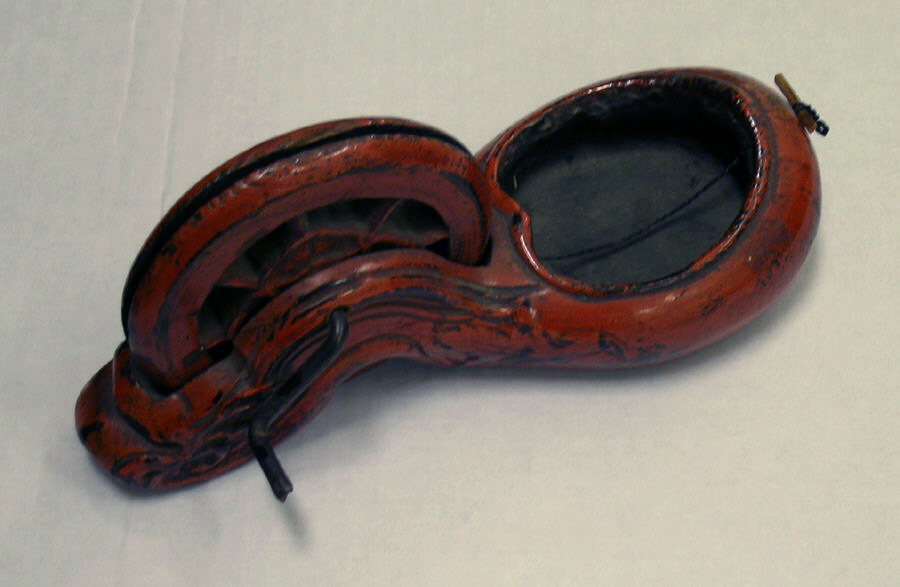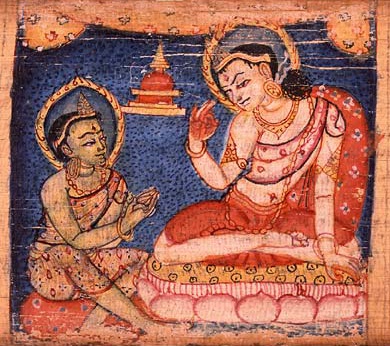|
Huayan
The Huayan school of Buddhism (, Wade–Giles: ''Hua-Yen,'' "Flower Garland," from the Sanskrit "''Avataṃsaka''") is a Mahayana Buddhist tradition that developed in China during the Tang dynasty (618-907).Yü, Chün-fang (2020). ''Chinese Buddhism: A Thematic History'', p. 160. University of Hawaii Press. The Huayan worldview is based primarily on the '' Buddhāvataṃsaka Sūtra'' ( zh, t=華嚴經, p=Huáyán jīng, ''Flower Garland Sutra'') as well as on the works of Huayan patriarchs, like Zhiyan (602–668), Fazang (643–712), Chengguan (738–839), Zongmi (780–841) and Li Tongxuan (635–730). Another common name for this tradition is the Xianshou school (''Xianshou'' being another name for patriarch Fazang).Hammerstrom, Erik J. (2020). ''The Huayan University network: the teaching and practice of Avataṃsaka Buddhism in twentieth-century China'', chapter 1. Columbia University Press. The Huayan School is known as Hwaeom in Korea, Kegon in Japan and Hoa Nghi ... [...More Info...] [...Related Items...] OR: [Wikipedia] [Google] [Baidu] |
Fazang
Fazang (; 643–712) was a Sogdian- Chinese Buddhist scholar, translator, and religious leader of the Tang dynasty. He was the third patriarch of the Huayan school of East Asian Buddhism, a key figure at the Chinese Imperial Court, and an influential Chinese Buddhist philosopher. Some scholars see him as the main figure in or even '' de facto'' founder of the Huayan school. Fazang's ancestors came from the Central Asian region of Sogdia, a major center for Silk Road trade, but he was born in the Tang capital of Chang'an (now Xi'an), where his family had become culturally Chinese. Fazang was known for his skill as a translator, knowledge of Sanskrit, and for his efforts to produce a new translation of an extended edition of the '' Gaṇḍavyūha sūtra.'' He also composed an original commentary on the ''Avatamsaka Sutra'', called the ''Huayan jing tanxuan ji'' (''Record of Investigating the Mystery of the Huayan jing'').Lin, Weiyu (2021)''Exegesis-philosophy interplay : intr ... [...More Info...] [...Related Items...] OR: [Wikipedia] [Google] [Baidu] |
Chengguan (monk)
Qingliang Chengguan (; Korean: Jinggwan; Japanese: Chōgan, 738–839 or 737-838 CE), was an important scholar-monk and patriarch of the Huayan school of Chinese Buddhism also known as Huayan pusa (bodhisattva Avatamsaka) and Qingliang Guoshi (Imperial Preceptor "Clear and Cool", Clear and Cool is a name for Mount Wutai)."Chengguan", in Buswell and Lopez (2013), ''The Princeton Dictionary of Buddhism,'' pp. 179-178. Princeton University Press.Hamar, I"Chengguan" in Silk, J. Brill’s Encyclopedia ''of Buddhism, Volume II: Lives.'' Chengguan is most widely known for his extensive commentaries and sub-commentaries to the ''Avataṃsaka Sūtra'' (''Huayan jing''), as well as for his translation of a new '' Gandhavyuha sutra'' version, together with the Indian monk Prajña. Chengguan's commentaries on the ''Avataṃsaka'' quickly became one of the authoritative sources for Huayan doctrine. Chengguan lived through the reigns of nine emperors and was an honored teacher to seven ... [...More Info...] [...Related Items...] OR: [Wikipedia] [Google] [Baidu] |
Guifeng Zongmi
Guifeng Zongmi () (780–1 February 841) was a Tang dynasty Chinese Buddhist monk and scholar who is considered a patriarch of both the Huayan school and Chan Buddhism. Zongmi wrote a number of works on several Mahayana Sutras, Chan and Huayan, and he also discussed Taoism and Confucianism. His works are a major source for studying the various Chan schools of the Tang. Zongmi was deeply interested in both the practical and doctrinal aspects of Mahayana Buddhism, especially the teachings of the '' Sutra of Perfect Enlightenment'' and the '' Mahayana Awakening of Faith''. Zongmi's work is concerned with harmonizing the various Chan teachings (especially the doctrines of sudden awakening and original enlightenment) with other Chinese Buddhist traditions, especially Huayan, though he also drew on the work of Tiantai Zhiyi in his ritual works. His philosophy attempts to create a comprehensive worldview that includes and sublimates all Buddhist and non-buddhist teachings of his t ... [...More Info...] [...Related Items...] OR: [Wikipedia] [Google] [Baidu] |
Zhiyan
file:智俨.jpg, Chinese carving of Zhiyan Zhiyan () (602–668) was a prominent monk of the Tang dynasty who is considered the second patriarch of the Buddhism in China, Chinese Buddhist Huayan school, Huayan school.Li, Zhihua [李治華]“An Inquiry into the Sources of Zhiyan’s Thought.” Department of Buddhist Studies, Huafan University. Huayan Studies, no. 135. [〈智儼思想來源論考〉,《華梵大學佛教學系》,《華嚴研究》,第135期。/nowiki>] He was a disciple of the foundational figure Dushun (杜順) and later became the mentor to both Fazang (法藏), who systematized Huayan doctrines, and the Korean monk Uisang (義湘). During his lifetime, Zhiyan was often referred to by honorific titles such as “Master Zhixiang” (至相大師) and “The Venerable of Yunhua” (雲華尊者). Life Zhiyan was born in the second year of the Renshou era under Emperor Wen of the Sui dynasty (602 CE). His father was Zhao Jing, who served as an assistant o ... [...More Info...] [...Related Items...] OR: [Wikipedia] [Google] [Baidu] |
Vairocana
Vairocana (from Sanskrit: Vi+rocana, "from the sun" or "belonging to the sun", "Solar", or "Shining"), also known as Mahāvairocana (Great Vairocana), is a major Buddha from Mahayana and Vajrayana Buddhism. Vairocana is often interpreted, in texts like the '' Avatamsaka Sutra'', as the Dharmakāya of the historical Gautama Buddha. In East Asian Buddhism ( Chinese, Korean, Japanese and Vietnamese Buddhism), Vairocana is also seen as the dharmakāya (the supreme buddha-body, the body of ultimate reality), and the embodiment of the Buddhist concept of wisdom and purity. Mahāvairocana is often translated into East Asian languages as "Great Sun Buddha" ( Chinese: 大日如來, pinyin: ''Dàrì Rúlái'', Japanese: ''Dainichi Nyorai''). In the conception of the Five Jinas of Mahayana and Vajrayana Buddhism, Vairocana is at the centre and is often considered a Primordial Buddha. In East Asian esoteric Buddhism, Mahāvairocana is considered to be a Cosmic Buddha whose body is th ... [...More Info...] [...Related Items...] OR: [Wikipedia] [Google] [Baidu] |
Buddhāvataṃsaka Sūtra
The ''Buddhāvataṃsaka-nāma-mahāvaipulya-sūtra (The Mahayana, Mahāvaipulya Sūtra named "Buddhāvataṃsaka")'' is one of the most influential Mahayana sutras, Mahāyāna sutras of East Asian Buddhism.Hamar, Imre. Buddhāvataṃsakasūtra, 2015, in ''Brill's Encyclopedia of Buddhism'' (Volume One), Handbook of Oriental Studies. Section 2 South Asia, Volume: 29-1. Editor-in-Chief: Jonathan Silk. It is often referred to in short as the '. In Classical Sanskrit, ''avataṃsa'', ''vataṃsa'' and ''uttaṃsa'' (from stem ''taṃs'', meaning "to decorate") all mean garland, wreath, or any circular ornament, such as an earring''''; suffix -ka often functions either as a diminutive or plural. Thus, the title may be rendered in English as ''A Garland of Buddhas'', ''Buddha Ornaments'', or ''Buddha's Fine Garland''. In Buddhist Hybrid Sanskrit, the term ''avataṃsaka'' means "a great number," "a multitude," or "a collection." This is matched by the Tibetan title of the sutra, wh ... [...More Info...] [...Related Items...] OR: [Wikipedia] [Google] [Baidu] |
Chinese Buddhism
Chinese Buddhism or Han Buddhism ( zh, s=汉传佛教, t=漢傳佛教, first=t, poj=Hàn-thoân Hu̍t-kàu, j=Hon3 Cyun4 Fat6 Gaau3, p=Hànchuán Fójiào) is a Chinese form of Mahayana Buddhism. The Chinese Buddhist canonJiang Wu, "The Chinese Buddhist Canon" in ''The Wiley Blackwell Companion to East and Inner Asian Buddhism'', p. 299, Wiley-Blackwell (2014). draws from the traditions of Confucianism and Taoism as well as the rituals of local Chinese folk religion, folk religions. Chinese Buddhism emphasizes the study of Mahayana sutras and treatises. Some of the most important scriptures in Chinese Buddhism include the ''Lotus Sutra'', ''Avatamsaka Sutra, Flower Ornament Sutra'', Vimalakirti Sutra, ''Vimalakirtī Sutra'', ''Mahāyāna Mahāparinirvāṇa Sūtra, Nirvana Sutra,'' and Shorter Sukhāvatīvyūha Sūtra, ''Amitābha Sutra''. Chinese Buddhism is the largest institutionalized religion in mainland China.Cook, Sarah (2017). The Battle for China's Spirit: Religious R ... [...More Info...] [...Related Items...] OR: [Wikipedia] [Google] [Baidu] |
Li Tongxuan
Li Tongxuan () (635–730) was a lay Chinese Buddhism, Chinese Buddhist scholar and meditation master of the Huayan, Huayan school. Background Li Tongxuan was the lesser known contemporary of the great Huayan scholar Fazang. Li is known for his exegetical writings on the Buddhāvataṃsaka Sūtra, ''Huayan Sutra'' (''Avatamsaka Sutra''), including his commentary entitled ''Xin Huayan Jing Lun'' (新華嚴經論, ''Treatise on the new translation of the Avatamsaka Sutra).Hammerstrom, Erik J. (2020). ''The Huayan University network: the teaching and practice of Avataṃsaka Buddhism in twentieth-century China'', chapter 1. Columbia University Press.Hamar, Imre (Editor). Reflecting Mirrors: Perspectives on Huayan Buddhism (ASIATISCHE FORSCHUNGEN), 2007, page XV.'' In his commentary to the ''Huayan sutra,'' Li argues that all sentient beings already have the same qualities possessed by a Buddha and thus, he sees the Huayan teaching as a sudden teaching which reveals the Buddhahoo ... [...More Info...] [...Related Items...] OR: [Wikipedia] [Google] [Baidu] |
Awakening Of Faith In The Mahayana
''Awakening of Faith in the Mahāyāna'' (AF, , reconstructed Sanskrit title: ''*Mahāyāna-śraddhotpāda-śāstra'') is an influential Mahayana Buddhist treatise for East Asian Buddhism. Though traditionally attributed to the 2nd century CE Indian master Aśvaghoṣa, no Sanskrit version is extant and it is widely regarded by many contemporary scholars as having been composed in China.Gardner, Alex"On the ''Awakening of Faith in the Mahāyāna''."''Buddha-Nature: A Tsadra Foundation Initiative'', October 9, 2019. The main theories of the authorship of the ''Awakening of Faith'' among contemporary scholars now point to either the 6th century Indian monk translators Paramārtha and Bodhiruci, or alternatively to one of their Chinese students. Origin and authorship While the text is traditionally attributed to Aśvaghoṣa, no Sanskrit version of the text is extant. The two earliest existing versions are written in Chinese, and contemporary scholars widely accept the theory t ... [...More Info...] [...Related Items...] OR: [Wikipedia] [Google] [Baidu] |
Mahayana
Mahāyāna ( ; , , ; ) is a term for a broad group of Buddhist traditions, Buddhist texts#Mahāyāna texts, texts, Buddhist philosophy, philosophies, and practices developed in ancient India ( onwards). It is considered one of the three main existing branches of Buddhism, the others being Theravāda and Vajrayāna.Harvey (2013), p. 189. Mahāyāna accepts the main scriptures and teachings of Early Buddhist schools, early Buddhism but also recognizes various doctrines and texts that are not accepted by Theravada Buddhism as original. These include the Mahāyāna sūtras and their emphasis on the ''bodhisattva'' path and Prajnaparamita, ''Prajñāpāramitā''. Vajrayāna or Mantra traditions are a subset of Mahāyāna which makes use of numerous Tantra, tantric methods Vajrayānists consider to help achieve Buddhahood. Mahāyāna also refers to the path of the bodhisattva striving to become a fully awakened Buddha for the benefit of all sentience, sentient beings, and is thus also ... [...More Info...] [...Related Items...] OR: [Wikipedia] [Google] [Baidu] |




